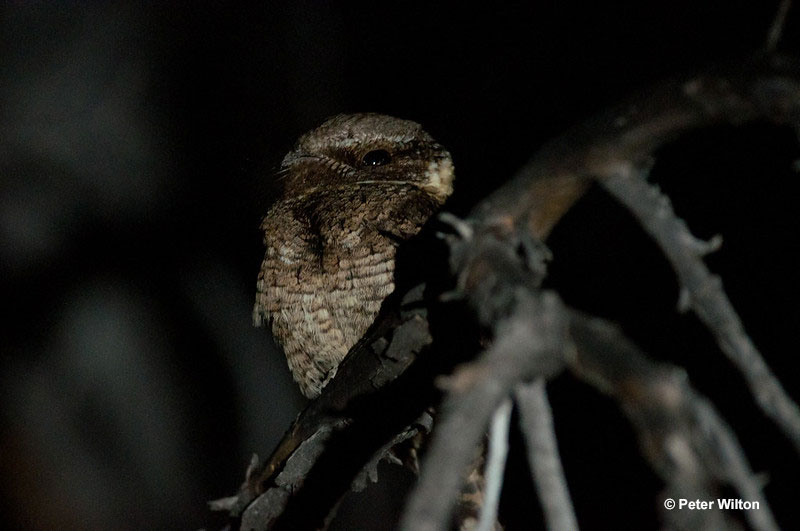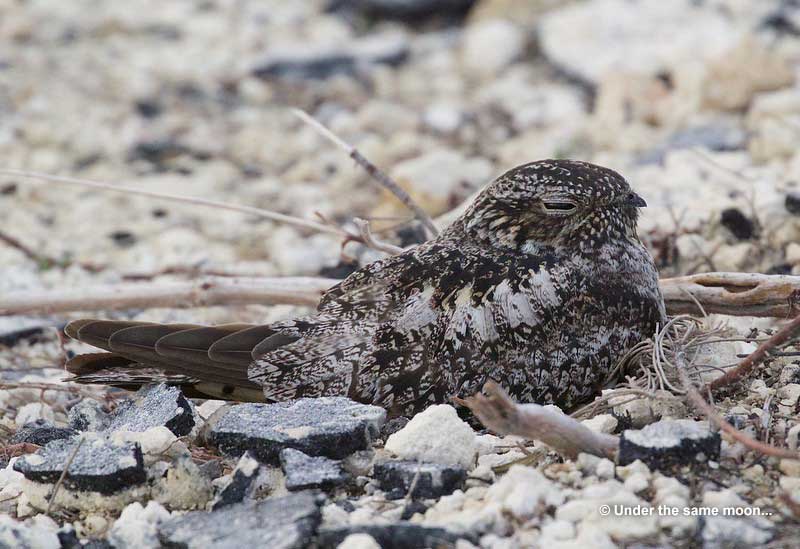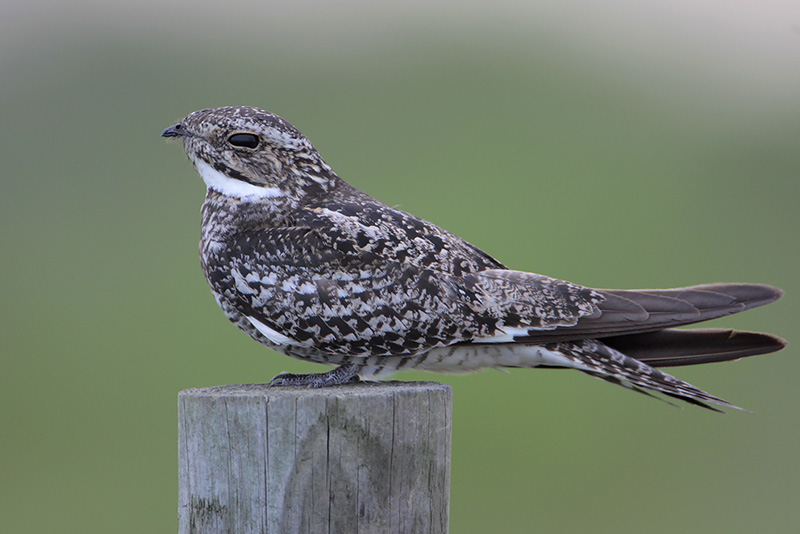
Nightjars are highly camouflaged birds, who are known for their intriguing calls.
A bird whistles, “Whip-poor-will!” over and over in the dark of the night. Headlights on a dusty south Texas track reveal a moth-like bird with glowing red eyes. As night falls on the Great Plains, a falcon-like bird with long pointed wings flutters high overhead and exclaims, “peent!”.
All of these birds belong to a unique, nocturnal family, the Nightjars.
Types of Nightjars
Nightjars belong to the bird family known as the “Caprimulgidae.” All Nightjars are nocturnal, and many have similar, mottled plumage that hides them in the day.
All species also have wide mouths with bristles that help them catch bugs, and fairly long wings.
Although they can look similar, there are two main types of “Caprimulgids.” The Nighthawks of North and South America and the Eared-Nightjars of Asia are aerialists that spend most of their time flying over forest and grasslands. Like swallows of the night, these birds flutter and glide through the night sky to catch high-flying insects.
The other Nightjars forage more like flycatchers. They sit on the ground or use a low perch and then fly out to catch insects in the air.
A few other tropical species also have incredibly long tails and elongated feathers on their wings.
Various members of this family live in forest, grasslands, and other types of habitats on all continents except for Antarctica. Most species live in tropical areas but the Common Nighthawk breeds as far north as northern Canada, and the Eurasian Nightjar breeds in northern Europe. These and some other species migrate to tropical regions for the winter.
Common Nightjars in the United States
Nine species of Nightjars live in the United States of America, but a few are more common than other birds. One additional species, the Gray Nightjar, has also occurred in Alaska as an accidental vagrant migrant.
The nine regular species all breed in parts of the USA, and most migrate to tropical regions for the winter. The most commonly seen Nightjars in the United States are the Common Nighthawk and the Lesser Nighthawk of the American Southwest.
In western states, the Common Poorwill is also a common bird fairly easy to see in many areas.
Common Poorwill
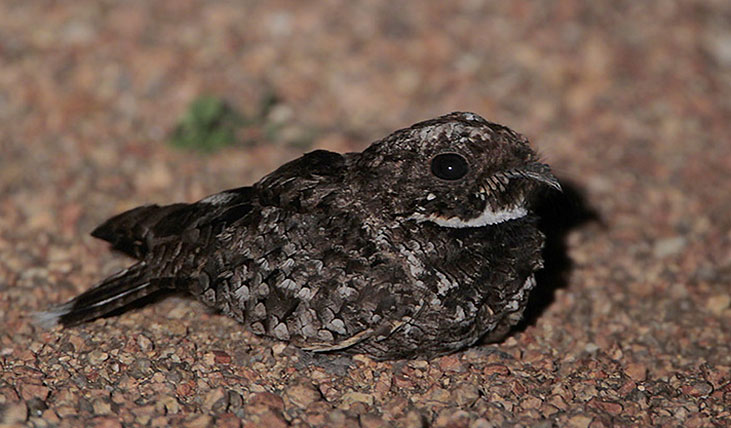
- Range: A few parts of southwestern Canada, and much of the western USA east to central Kansas. It also lives in Mexico.
- Length: 7.75 inches.
The Common Poorwill is a small, moth-like bird around the same size as a grosbeak. It is mottled gray with some black markings, and has buff under its wings and on its lower belly and undertail.
It also has a blackish face with some white on its throat. Both sexes look alike, although males have white corners on their dark tail.
Common Poorwills also have a big, flat head, fairly long, rounded wings, and a medium-length tail.
This species lives in grasslands, deserts, and other arid habitats from low to fairly high elevations. Common Poorwills migrate to the American Southwest and Mexico for the winter. However, birds that breed in California, southern Arizona, and southern Texas are present all year long.
Related: Best Bird Identification Apps
In cold weather, the Common Poorwill can hibernate anywhere from a few hours to several days.
The Common Poorwill repeats its name, “poor will, poor will, poor will.”
Common Pauraque
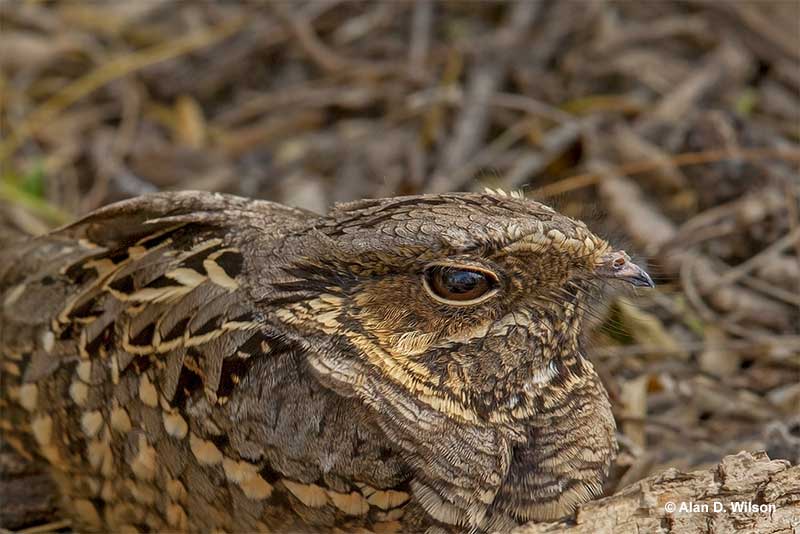
- Range: The southernmost part of Texas, Mexico, and Central and South America.
- Length: 11 inches.
The Common Pauraque is mottled brown, gray, and reddish-brown, and has a reddish-brown patch on its face. It has dark bands on its long tail, and small pale spots on its closed wings.
This species has a dark mark on the center part of its flat head, tan edging to feathers where its wings meet its back, and indistinct barring on pale brown underparts.
In flight, the Common Pauraque shows a white band near the tip of each wing, and a lot of white in its tail. Males show a lot more white in their tail than females.
Common Pauraques are tropical birds that live in scrubby habitats and weedy fields. They are often seen at night as they sit on quiet roads and then fly up as a car approaches.
This species makes whistled calls that sound like its common Spanish name, “Cuyeo”. It usually says, “whut whit whit whit ooWEEoo.”
Did you know? Historically, nightjars were called goatsuckers. There’s even one that’s called the Satanic Goatsucker!
Chuck-will’s-widow
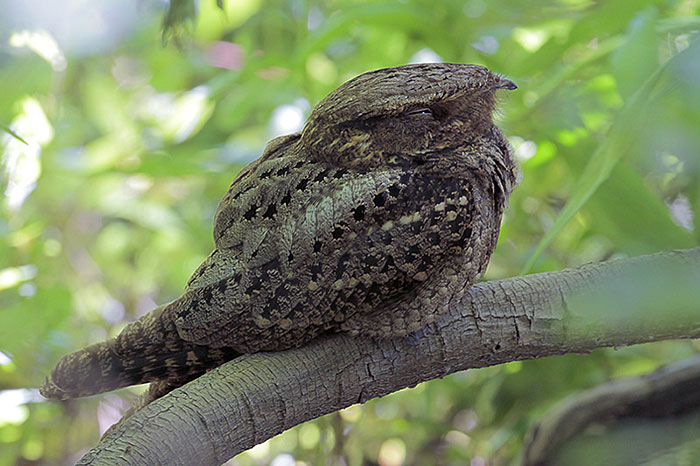
- Range: The southeastern USA north to Missouri and southern New Jersey, and west to central Texas.
- Length: One foot.
The Chuck-will’s-widow is a big Nightjar with a large, flat head. It can be mottled reddish-brown, or mostly gray, and has short, dark streaks on its gray crown.
It also has a brown patch on its face, some black spots on the gray shoulders of its wings, and faint barring on brown underparts.
Chuck-will’s-widows have dark barring on the feathers of their long, reddish-brown wings, and dark bands on their long tail.
Did you know: Nightjars are related to Potoos, also known as Ghost Birds.
Both sexes look the same except that male Chuck-will’s-widows have a lot of white on their tail. Females only have small, buffy tips on their tail.
This species breeds in a variety of pine and mixed woodlands. It often forages in brushy and semi-open areas at night, and rests on a tree branch in the day.
The Chuck-will’s-widow is another Nightjar species that says its name. On spring and summer nights in the south, it whistles, “chuck, widow widow…chuck, widow widow.”
Buff-collared Nightjar
- Range: In the USA, it only occurs in a few areas of southeastern Arizona.
- Length: 8.75 inches.
The Buff-collared Nightjar is a small to medium-sized nightjar with mottled gray plumage. It has a prominent buffy collar, a plain gray crown, and a dark brown face and throat.
This species also has some black markings on its back, buff marks where the wings meet its back, and some small black mottling on its wings.
Males and females look the same, but males have some white in their tail while females have buff tips on their tail feathers.
Buff-collared Nightjars also have dark barring on their tail, and fairly long, rounded wings with dark barring on reddish flight feathers.
The Buff-collared Nightjar lives in rocky canyons with mesquite and other scrubby vegetation. In the USA, most are seen at California Gulch and a few other spots in southern Arizona. They also live in similar rocky habitats in western Mexico and Central America.
The Buff-collared Nightjar has a rising staccato song. It says, “tuk..tuk took tuk tuktuktuktukt kuhCHEEya.”
Eastern Whip-poor-will
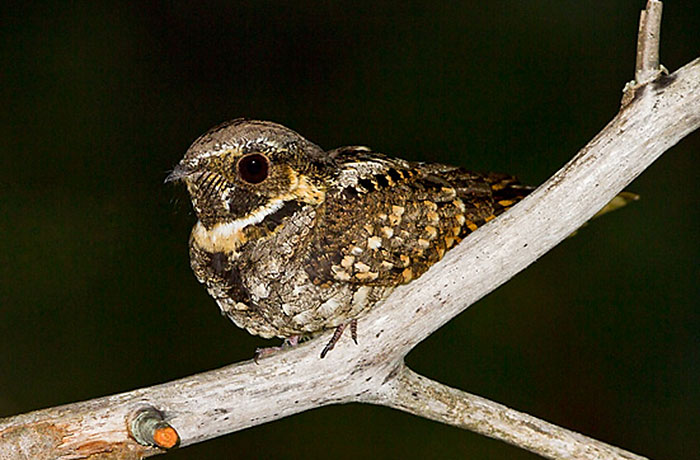
- Range: Parts of central and southeastern Canada, and the eastern USA.
- Length: 9.75 inches.
The Eastern Whip-poor-will is a small to medium-sized nightjar with mottled brown and gray plumage. It has a gray crown with a thick, blackish stripe down the middle, brown on its face, and a dark throat.
It has an obvious pale gray patch bordered with black markings where its wings meet its back, and some buff spots in its wings.
Males and females look the same except that males have large white patches on their long, blackish tail. Females only have buff on the tip of their tail but both sexes also have a buff lower belly and undertail.
The Whip-poor-will can also show a narrow white patch on the base of its throat, and has red-brown flight feathers with dark barring on its long wings.
Whip-poor-wills live in mature, hardwood forest habitats. They have become rare in various parts of their range.
This nightjar species whistles its name over and over, “whip-poor-will, whip-poor-will.”
Mexican Whip-poor-will
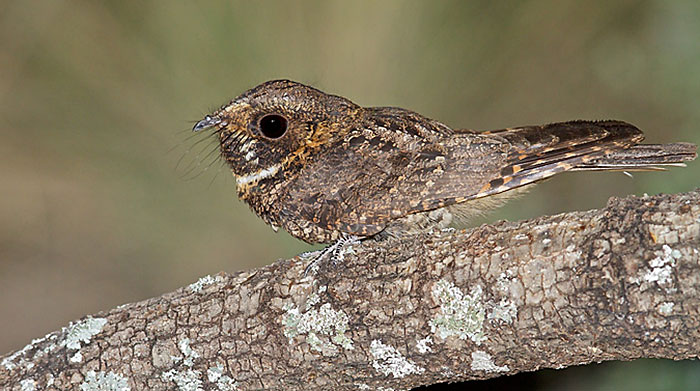
Photograph © Glenn Bartley
- Range: Mountains in Arizona, New Mexico, west Texas, a few areas in southern Nevada and southern California, Mexico, and Central America.
- Length: 9.75 inches.
The Mexican Whip-poor-will is a small to medium-sized, mottled brown, gray, and black nightjar. It has a thick, black stripe on the middle of its gray crown, a brown face, and a dark throat with a narrow white band.
This nocturnal bird species has a pale gray patch with black markings where its wings meet its back, and also has buff spots in its wings.
Males and females look similar, but males have big white patches on their long, dark tail. Females lack these white spots and have a tail with a buff tip. However, both sexes also have a buff undertail and buff lower belly.
The Mexican Whip-poor-will has long wings with dark barring on its reddish-brown flight feathers.
Mexican Whip-poor-wills occur in pine-oak, pine-juniper, and other similar montane habitats. The birds that live in the USA migrate south for the winter.
This nightjar species repeats a modulated, whistled phrase, “quick kuh WEEK quick kuh WEEK.”
Antillean Nighthawk
- Range: The Florida Keys and many islands in the Caribbean.
- Length: 8.5 inches.
The Antillean Nighthawk is a medium-sized, mottled gray and pale brown nightjar with a fairly long, forked tail. It also has dark barring on pale brown and whitish underparts, dark streaks on its face, and a white patch on the base of its throat.
When perched, this species shows some small black markings on its wings. The back part of its wings (the tertials) are pale gray.
Males and females look similar, except that males have a white band on their tail, and more white on their throat. Females can be more reddish-brown but always have little to no white on their throat, no white in their tail, and less white in their wings.
In flight, Antillean Nighthawks have long, pointed wings with black flight feathers. They show a white, crescent-shaped patch near the wingtip.
The Antillean Nighthawk lives in scrubby areas, open habitats, and pine forest. It makes a repeated vocalization of five notes, “peetapidadit.”
Common Nighthawk
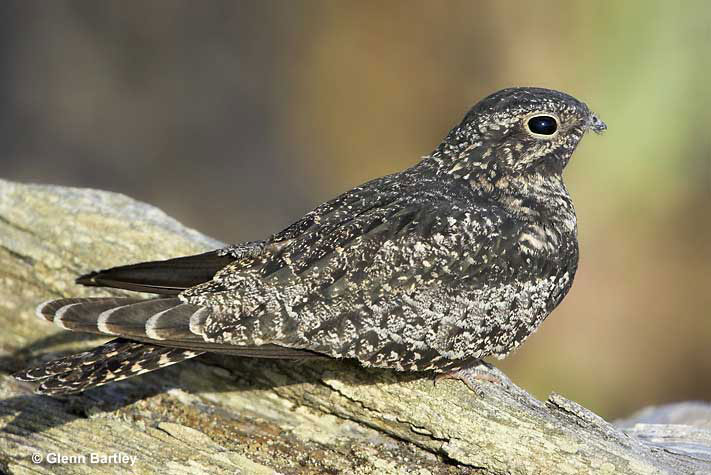
- Range: A large part of Canada and much of the USA south to Central America.
- Length: 9.5 inches.
The Common Nighthawk is a medium-sized, mottled gray and dark brown bird with a longish, forked tail. It has dark markings on its chest, dark barring on pale underparts, and some dark markings on its face and throat. This species also has a white patch on the base of its throat.
When perched, Common Nighthawks have mottled, pale gray, brown, and black wings.
The sexes look the same except that males are colder gray whereas females tend to have more brown-toned plumage. Males also have more white on their throat, a white band on their tail, and more white in their wings.
In flight, Common Nighthawks have long, pointed wings. They have black flight feathers with a prominent, crescent-shaped, white mark near each wingtip.
The Common Nighthawk lives in a wide variety of habitats. These birds occur in grasslands, meadows, woodlands, wetlands, and urban areas.
This species repeats a brief nasal call, “peeant.”
Lesser Nighthawk
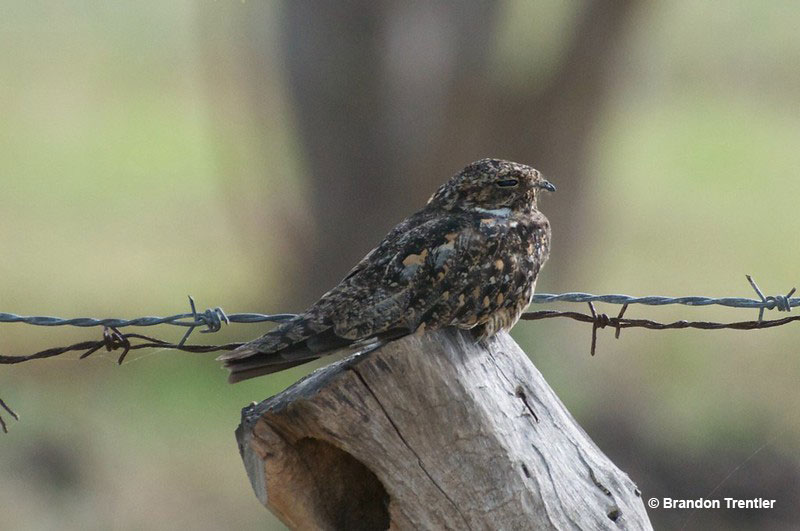
- Range: Parts of California, Nevada, Arizona, New Mexico, Texas, Mexico, and Central America.
- Length: 9 inches.
The Lesser Nighthawk is a medium-sized, mottled, ashy gray and pale brown nightjar species with a longish, forked tail. It has a grayish chest, dark barring on tan underparts, and some dark mottling on its face and throat. The Lesser Nighthawk also has a white patch on the base of its throat.
Perched Lesser Nighthawks have mottled, ashy gray wings with some small black markings, and buff spots.
Did you know: the Great-eared Nighjar, also known as the Dragon Bird, is part of the Nightjar family.
Males and females look similar, but males have a white band on their tail, and have a more prominent white patch on their throat.
In flight, Lesser Nighthawks flutter and glide on long, pointed wings. They have buff spotting on their flight feathers, and a pale, crescent-shaped mark near the blunt tips of each wing. This patch is white in males and buffy in females.
The Lesser Nighthawk lives in deserts and scrubby arid habitats.
This species makes a long, tremulous bubbling or trilling sound that can go on for twenty seconds.
Frequently Asked Questions
Are nightjars rare?
No, most nightjars are fairly common. However, their nocturnal behaviors can make them hard to see and a few species have also declined.
Are nightjars related to owls?
No, nightjars are not related to owls. Both types of birds have similar camouflaged plumage to hide them in the day, but owls are more related to hawks and eagles.
Where do nightjars live?
Nightjars live in forest, grasslands, deserts, and other habitats. Common Nighthawks can also live in urban areas.
What do nightjars eat?
Nightjars eat insects. They catch a wide variety of insects in flight.
Where are nightjars found?
Nightjars are found on every continent except for Antarctica. In North America, at least one species of nightjar lives in most regions.


